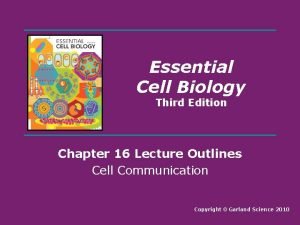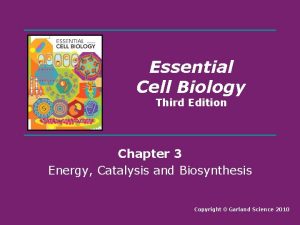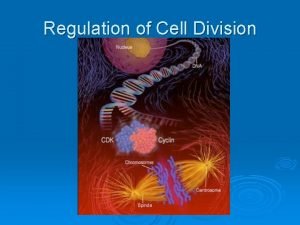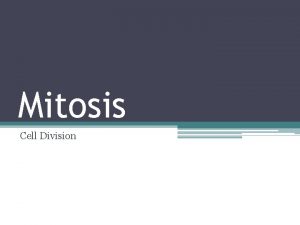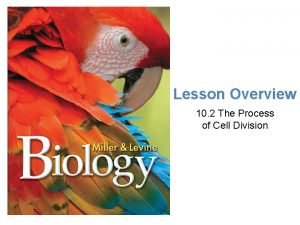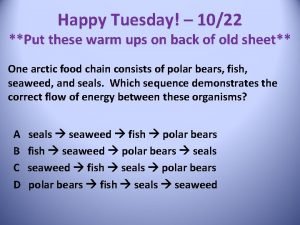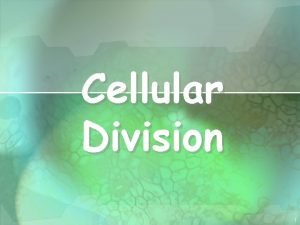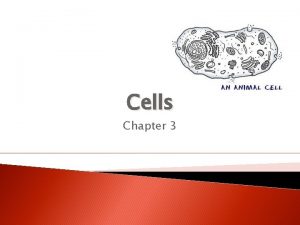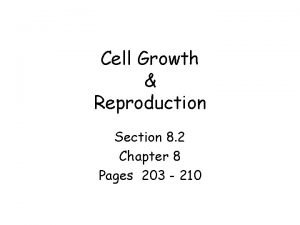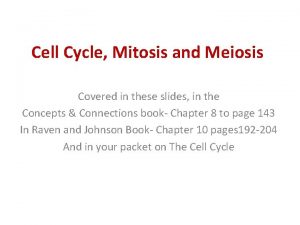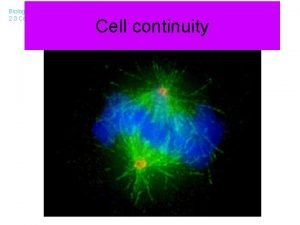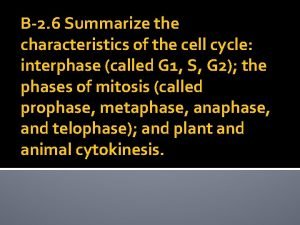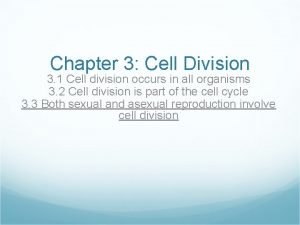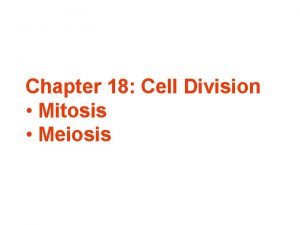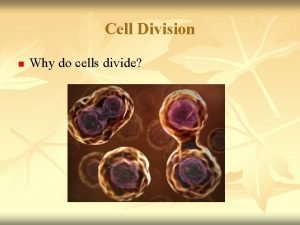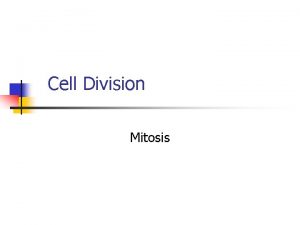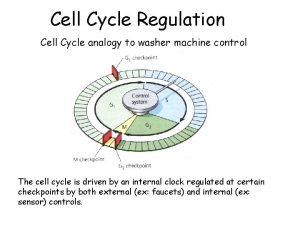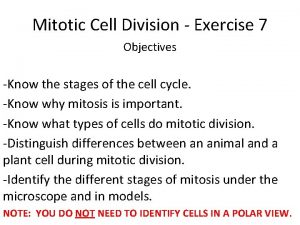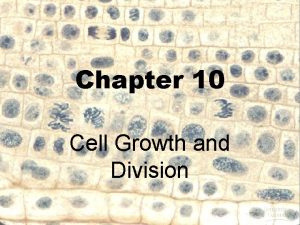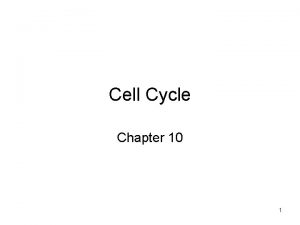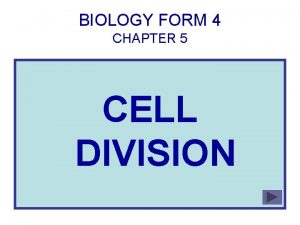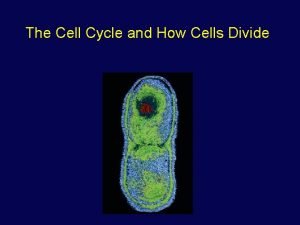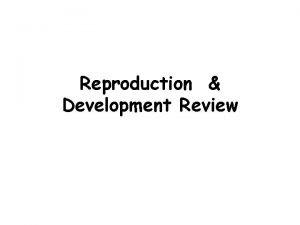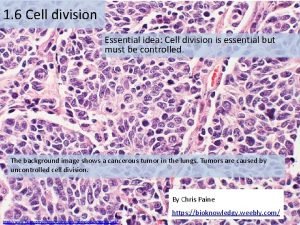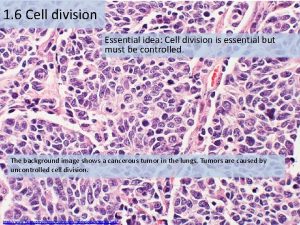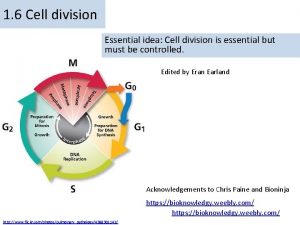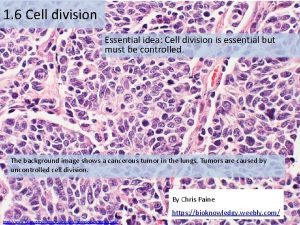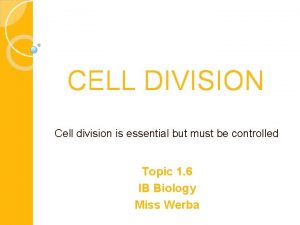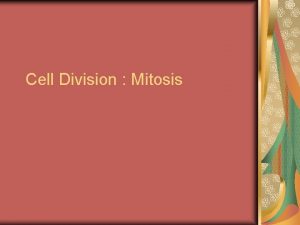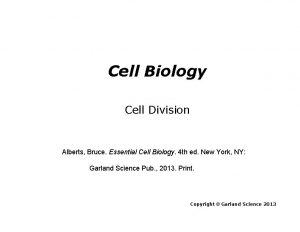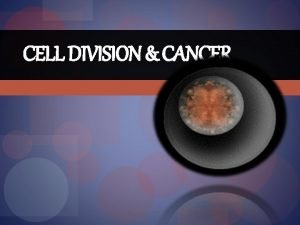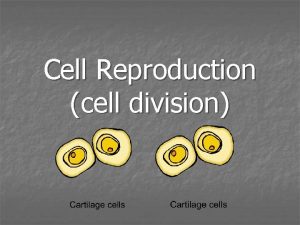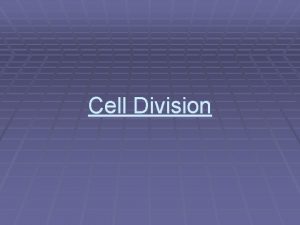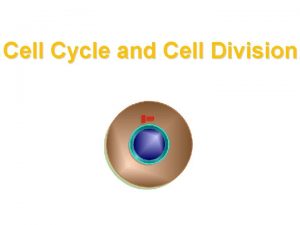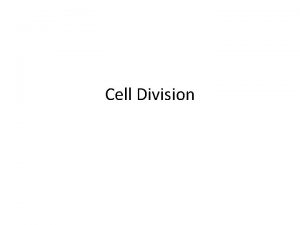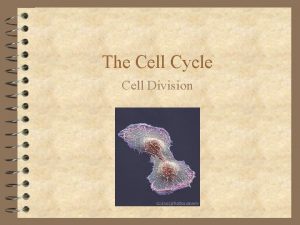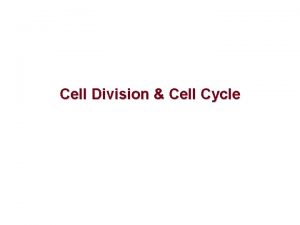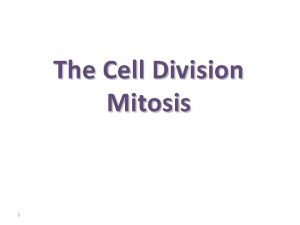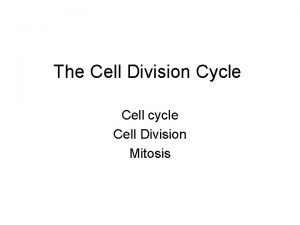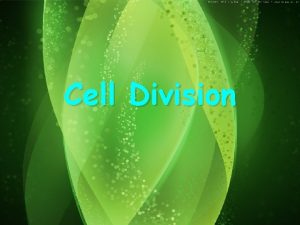1 6 CELL DIVISION Cell division is essential







































- Slides: 39

1. 6 CELL DIVISION Cell division is essential but must be controlled

Cell Cycle ■ The cell cycle is an ordered set of events which culminated in the division of a cell into two daughter cells. ■ It can be roughly divided into two main phases: – Interphase – M Phase

Interphase ■ The largest part of the cell cycle is interphase. ■ The stage in the development of a cell between two successive divisions. ■ This phase of the cell cycle is a continuum of three distinct stages. – G 1 -First intermediate gap stage in which the cell grows and prepared for DNA replication. – S- Synthesis stage in which DNA is replicated – G 2 - Second intermediate gap stage in which the cell finishes growing and prepares for cell division.


■ Interphase is a very active period in the cell cycle with many processes occurring in the nucleus and cytoplasm. (U. 4) ■ Many events need to occur in interphase to prepare the cell for successful division. – DNA Replication – Organelle duplication – Cell growth – Transcription/translation – Obtain nutrients – Respiration (cellular) – *DOCTOR

■ DNA is present as uncondensed chromatin (not visible under microscope) ■ DNA is contained within a clearly define nucleus ■ Centrosomes and other organelles have been duplicated ■ Cell is enlarged in preparation for division.

Mitosis ■ Mitosis is the division of the nucleus into two genetically identical daughter nuclei. (U. 1) ■ Mitosis is preceded by interphase and is divided into four distinct stages: – Prophase – Metaphase – Anaphase – Telophase



Before we begin……vocab ■ Chromatin: unraveled, loosely packed DNA within the nucleus – In this unraveled form, the DNA is accessible to be transcribed (copied) ■ Chromosome: DNA tightly wound and condensed (via supercoiling) – In this form, DNA is able to easily segregate, however it is inaccessible to transcription.


Prophase ■ DNA supercoils and chromosomes condense (becoming visible under microscope). – Chromosomes condense by supercoiling during mitosis. (U. 2) ■ Chromosomes are comprised of genetically identical sister chromatids (joined at a centromere) ■ Paired centrosomes move to the opposite poles of the cell and form microtubule spindle fibers ■ The nuclear membrane breaks and the nucleus dissolves.

Metaphase ■ Microtubule spindle fibers from both centrosomes connect to the centromere of each chromosome ■ Microtubule depolymerisation causes spindle fibers to shorten in length and contract. ■ This causes chromosomes to align along the center of the cell (metaphase plate)

Anaphase ■ Continued contraction of the spindle fibers causes genetically identical sister chromatids to separate. ■ Once the chromatids separate, they are each considered an individual chromosome. ■ The genetically identical chromosomes move to the opposite poles of the cell.

Telophase ■ Once the two chromosome sets arrive at the poles, spindle fibers dissolve ■ Chromosomes decondense (no longer visible under light microscope) ■ Nuclear membranes reform around each chromosome set ■ Cytokinesis occurs concurrently, splitting the cell into two.

Cytokinesis ■ Cytokinesis in the process of cytoplasmic division, where the cell splits into two identical daughter cells. ■ Cytokinesis occurs after mitosis and is different in plant and animal cells. (U. 3)

Cytokinesis: Animal Cells ■ After anaphase, microtubule filaments form a concentric ring around the center of the cell. ■ The microfilaments constrict to form a cleavage furrow, which deepens from the periphery towards the center. ■ When the furrow meets in the center, the cell becomes completely pinched off and two cells are formed. ■ Because this separation occurs from the outside and moves towards the center, it is described as centripetal.

Cytokinesis: Plant Cell ■ After anaphase, carbohydrate-rich vesicles form in a row at the center of the cell (equatorial plane). ■ The vesicles fuse together and an early plate begins to form within the middle of the cell. ■ The cell plate extends outwards and fuses with the cell wall, dividing the cell into two distinct daughter cells. ■ Because this separation originates in the center and moves laterally, it is described as centrifugal.


Cyclins ■ Cyclins are involved in the control of the cell cycle. (U. 5) ■ Cyclins are a family of regulatory proteins that control the progression of the cell cycle. ■ Cyclins activate cyclin dependent kinases (CDKs), which control cell cycle processes through phosphorylation. – When a cyclin and CDK form a complex, the complex will bind to a target protein and modify it via phosphorylation. – The phosphorylated target protein will trigger some specific event within the cell cycle (centrosome duplication, etc) – After the event has occurred, the cyclin is degraded and the CDK is rendered inactive again.


Cyclin Expression Patterns ■ Cyclin concentrations need to be tightly regulated in order to ensure the cell cycle progresses in a proper sequence. ■ Different cyclins specifically bind to, and activate, different classes of cyclin dependent kinases. ■ Cyclin levels will peak when their target protein in required for function and remain at lower levels at all other times.


Mitotic Index ■ Identification of phases of mitosis in cells viewed with a microscope or in a micrograph. (S. 1) ■ The mitotic index is a measure of the proliferation status of a cell population (i. e. the proportion of dividing cells) ■ The mitotic index may be elevated during processes that promote division, such as normal growth or cellular repair. – It also functions as an important prognostic tool for predicting the response of cancer cells to chemotherapy.

Identifying Mitotic Cells ■ Cells undergo mitosis will lack a clearly defined nucleus and posses visibly condensed chromosomes. – Prophase- Chromosomes condensed but still confined to a nuclear region. – Metaphase- Chromosomes aligned along the equator of the cell. – Anaphase- Two distinct clusters of chromosomes apparent at poles of the cell. – Telophases- Two nuclear regions present within a single cell (difficult to see as cytokinesis occurs


Calculating Mitotic Index ■ The mitotic index is the ration between the number of cells in mitosis and the total number of cells. ■ It can be determined by analyzing micrographs and counting the relative number of mitotic cells versus non-dividing cells.



Cancer Development ■ Mutagens, oncogenes and metastasis are involved in the development of primary and secondary tumors. (U. 6) ■ Tumor are abnormal cell growths resulting from uncontrolled cell division and can occur in any tissue or organ. ■ Diseases caused by the growth of tumors are collectively known as cancers.

Mutagens ■ A mutagen is an agent that changes the genetic material of an organism (either acts on the DNA or the replicative machinery). ■ Mutagens may be physical, chemical, or biological in origin: – Physical: Sources of radiation including X-rays, ultraviolet (UV) light and radioactive decay. – Chemical: DNA interacting substances including reactive oxygen species and metals (arsenic) – Biological: Viruses, certain bacteria and mobile genetic elements.


Oncogenes ■ An oncogenes is a gene that has the potential to cause cancer. ■ Most cancers are caused by mutations to two basic classes of genes – proto-oncogenes and tumor suppressor genes. – Proto-oncogenes code for proteins that stimulate the cell cycle and promote cell growth and proliferation. – Tumor suppressor genes code for proteins that repress cell cycle progression and promotes apoptosis. ■ When a proto-oncogene is mutated or subjected to increased expression it becomes a cancer-causing oncogene. ■ Tumor suppressor genes are sometimes referred to an antioncogenes, as their normal function prevents cancer.


Metastasis ■ Tumor cells may either remain in their original location (benign) or spread and invade neighboring tissue (malignant) ■ Metastasis is the spread of cancer from one location (primary tumor) to another, forming a secondary tumor. ■ Secondary tumors are made up of the same type of cell as the primary tumor – this affects the type of treatment required. – E. g. If breast cancer spread to the liver, the patient has secondary breast cancer of the liver (treat with breast cancer drugs).


Smoking and Cancer ■ A significant body of scientific literature exists which provides a strong link between smoking and the incidence of cancers. ■ Cigarette smoke contains over 4, 000 chemical compounds, over 60 of which are known to be carcinogenic. ■ There appears to be a strong positive correlation between the frequency of smoking and the development of cancer. ■ The risk of lung cancer is strongly correlated with smoking, with about 90% of such cancers attributable to tobacco use. ■ Smoking also increases the risk of over a dozen other cancers, including mouth, stomach, liver, pancreas and bowel. ■ The correlation between smoking and incidence of cancers. (A. 1)


 Characteristics of lipids
Characteristics of lipids Cell cycle and cell division
Cell cycle and cell division Cell cycle and cell division
Cell cycle and cell division Mitosis
Mitosis Signal transduction
Signal transduction Cell biology third edition
Cell biology third edition Long division and short division
Long division and short division Synthetic division of polynomials
Synthetic division of polynomials Long and short division
Long and short division Polynomial short division
Polynomial short division Cell division acronym
Cell division acronym Frequency of cell division
Frequency of cell division Mitosis
Mitosis Why is cell division important
Why is cell division important Prophase stage of mitosis
Prophase stage of mitosis Cell division acronym
Cell division acronym When is a tetrad formed
When is a tetrad formed Chapter 3 cells
Chapter 3 cells Chapter 8 cell growth and division section 8-2 answer key
Chapter 8 cell growth and division section 8-2 answer key Mitosis sexual reproduction
Mitosis sexual reproduction Mitosis meiosis
Mitosis meiosis Do sister chromatids separate in meiosis
Do sister chromatids separate in meiosis Centrioles and asters
Centrioles and asters Cell continuity
Cell continuity Prophase 1
Prophase 1 The disadvantages of sexual reproduction
The disadvantages of sexual reproduction Chromosome structure
Chromosome structure Mitosis
Mitosis Unicellular cell division
Unicellular cell division Equator in mitosis
Equator in mitosis Cell division
Cell division Cell division vocabulary
Cell division vocabulary Cell cycle analogy
Cell cycle analogy Prophase microscope
Prophase microscope Telopahse
Telopahse Section 10-1 cell growth
Section 10-1 cell growth Cell division
Cell division Meiosis concept map
Meiosis concept map Function of cell division
Function of cell division What process is this
What process is this




